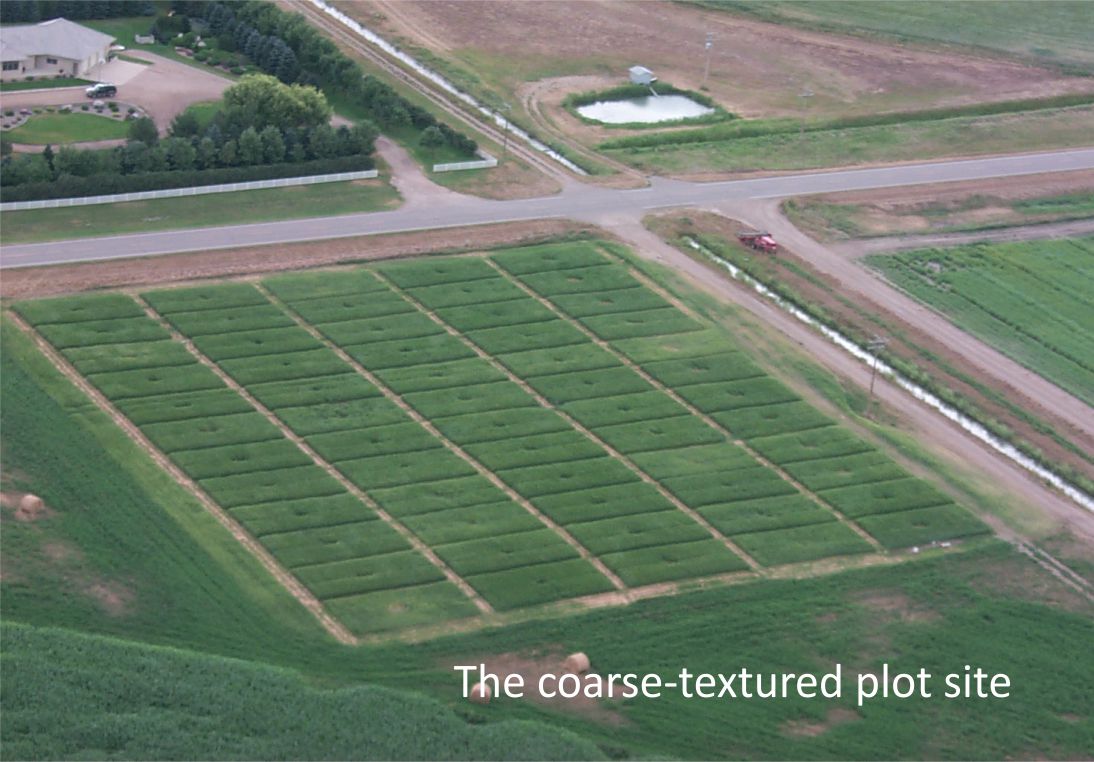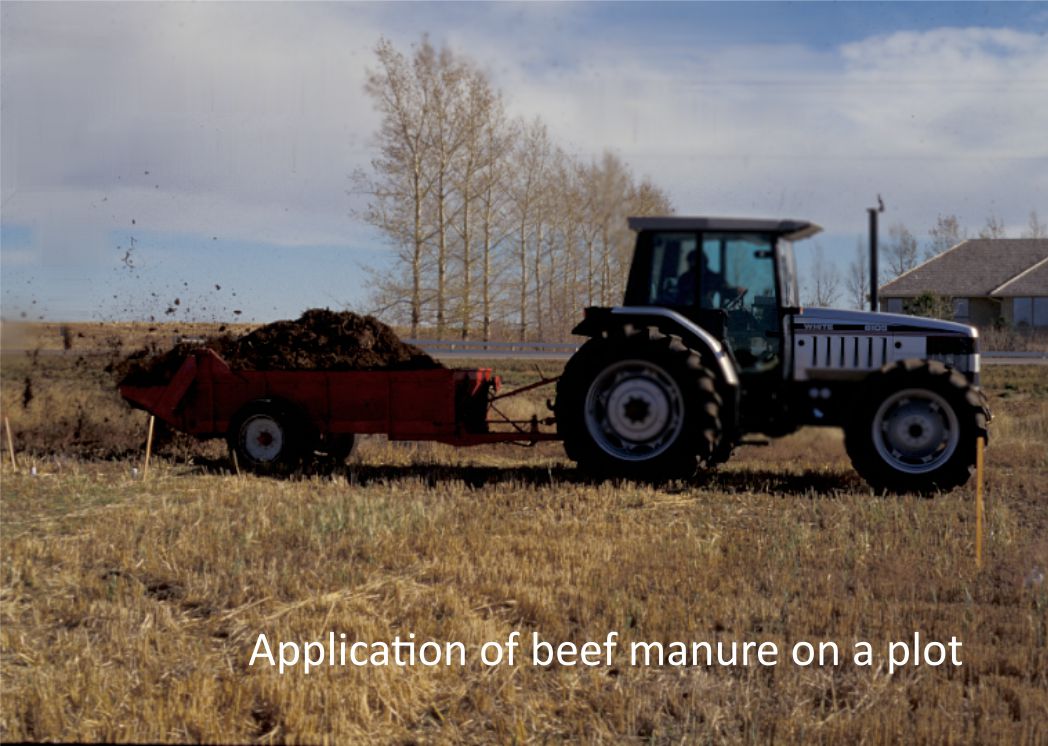| | Introduction | Study methods | Findings | Conclusions | Project support | Publications | For more information
Introduction
The most efficient and simplest means of utilizing livestock manure is to apply it on agricultural land. The regionalization and growth of the livestock sector in many areas has resulted in large, concentrated volumes of manure. There is concern that manure can pose a serious threat to soil, water, and quality resources if manure is not managed properly. The livestock sector is an important part of Alberta’s agricultural industry. Sustainable management of manure generated by confined feeding operations is essential to the industry, in terms of environmental protection, social acceptance, and economical viability. Practices that integrate manure as a nutrient resource into cropping systems, without adversely affecting soil and water resources, need to be developed. To address this, a field study was started in southern Alberta in 1993. The study had two overall objectives: (1) to determine the effects of repeated application of cattle manure on soil quality, shallow groundwater quality, and crop production on two soil types under irrigated conditions; and (2) based on the results, to make appropriate recommendations for the management of manure application on land to minimize or prevent detrimental effects on soil and groundwater resources.
Study Methods

Two field sites were established near Lethbridge, Alberta, Canada: one on a sandy-loam soil (coarse-textured site) and the other on a loam to clay-loam soil (medium-textured site). The experimental design included a control, three rates of fertilizer-N (60, 120, 180 kg ha- 1 y -1 nitrogen as urea), and four rates of cattle manure (20, 40, 60, and 120 Mg ha- 1 y -1; wet-weight basis). Manure treatments were applied each fall from 1993 to 2000, and the fertilizer-N treatments were applied each spring from 1994 to 2001. Treatments were replicated five times in a randomized complete block design. Soil samples were taken annually after harvest, but prior to manure application. Soil samples were also collected in the spring and during the growing season for selected years. Soil analyses included nitrate-N, ammomium-N, orthophosphate-P, calcium, magnesium, potassium, sodium, sulphate-S, and bicarbonate, pH, electrical conductivity, total nitrogen, and total phosphorus. Aggregate size distribution was also measured. Groundwater wells were installed in the centre of each plot, and groundwater samples were collected once per month from about April to November of each year. Groundwater samples were analysed for nitrate-N and chloride content. The sites were seeded to either barley or triticale from 1994 to 2001. The crops were harvested at the silage stage, and both sites were irrigated as required. Crop yield was recorded and crop-tissue samples were analysed for total nitrogen, total phosphorus, and total calcium.
Findings
Eight years of manure application significantly increased soil nitrate-N, orthophosphate-P, total nitrogen, total phosphorus, sodium, potassium, magnesium, chloride, bicarbonate, sodium adsorption ratio, and electrical conductivity. Extractable soil calcium, sulphate-S, and pH, for the most part, were not affected by manure application. The fertilizer-N treatments essentially had no effect on soil properties or groundwater quality, with the exception of nitrate-N cumulation in the soil profile.
The addition of salts from the manure caused soil salinity to increase and the dominant extractable cation to shift from calcium to potassium. The application of manure also increased soil sodicity, which may result in degradation in soil structure. Degradation in soil structure may not necessarily occur if salt content is also increased. A one-time assessment of aggregate size distribution in the soil surface layer showed that manure application promoted aggregate formation at both sites. This may be a temporary benefit due to the added organic matter, but if soil sodicity levels are allowed to continue to build-up from heavy manure application, potassium and sodium may cause degradation of soil structure in the long term.
Repeated manure and fertilizer-N applications caused a build-up of nitrate-N in the soil profile. The excess nitrate-N leached through the soil profile at both sites. Nitrate-N moved downward at about 0.3 to 0.35 m per year at the medium-textured site, whereas nitrate-N moved throughout the soil profile (1.5 m) at the coarse-textured site within one year. For every megagram of total nitrogen added from manure, soil extractable nitrate-N increased by 40.7 to 95.1 kg ha-1 in the 0 to 1.5-m layer.
Net phosphorus cumulation from manure in the 0 to 0.15-m soil layer increased by 64 kg ha-1 for the 20 Mg ha-1 manure rate and 730 kg ha-1 for the 120 Mg ha-1 manure rate at the coarse-textured site after eight years of manure application. Corresponding net increases at the medium-textured site were 131 and 1127 kg ha-1, respectively. The extractable orthophosphate-P status in the 0 to 0.15-m soil layer at the end of the study was well above the agronomic requirements for crops, even for the 20 Mg ha-1 y-1 rate. The vast majority of cumulated orthophosphate-P remained in the 0 to 0.15-m soil layer at the medium-textured site, whereas some orthophosphate-P leached into the 0.15 to 0.6-m layer at the coarse-textured site. For every megagram of total phosphorus added from manure, soil extractable orthophosphate-P increased by 400 to 421 kg ha-1 in the 0 to 0.6-m layer.
 Groundwater nitrate-N content was not affected by the manure or fertilizer-N treatments at the medium-textured site. Groundwater nitrate-N and chloride concentrations at the coarse-textured site were affected by the cumulation of nitrate-N and chloride from manure application and subsequent movement downward through the soil profile. Results from this site for the first four years were confounded by initially high levels of nitrate and chloride in the soil, presumably from past manure applications by the land owner. However, there was a clear relationship between the build-up and removal of nitrate-N and chloride in the soil and what was observed in the groundwater. As the initially high amounts of the nitrate-N and chloride were leached from the soil profile during the first four years of the study, a corresponding increase was observed in the groundwater. In the subsequent three years, nitrate-N and chloride began to re-cumulate in the soil profile, and as a result, less nitrate-N and chloride entered the groundwater. Groundwater nitrate-N content was not affected by the manure or fertilizer-N treatments at the medium-textured site. Groundwater nitrate-N and chloride concentrations at the coarse-textured site were affected by the cumulation of nitrate-N and chloride from manure application and subsequent movement downward through the soil profile. Results from this site for the first four years were confounded by initially high levels of nitrate and chloride in the soil, presumably from past manure applications by the land owner. However, there was a clear relationship between the build-up and removal of nitrate-N and chloride in the soil and what was observed in the groundwater. As the initially high amounts of the nitrate-N and chloride were leached from the soil profile during the first four years of the study, a corresponding increase was observed in the groundwater. In the subsequent three years, nitrate-N and chloride began to re-cumulate in the soil profile, and as a result, less nitrate-N and chloride entered the groundwater.
The results from the two sites showed that after a few years of annual manure application there were essentially no crop-yield differences among the three fertilizer-N and four manure rates, but they yielded significantly more than the control. Under the application regime of our study, the 20 Mg ha-1y-1 treatment provided the nutrient requirements for the crop within a few years of repeated applications. The only time that a negative effect was observed was in 1998 when manure and fertilizer-N caused the crop to lodge, and the extent of lodging increased with application rate. The application of manure and fertilizer-N caused an increase in total nitrogen content in crop tissue, whereas there was minimal effect on total phosphorus and total calcium content in crop tissue.
Discontinuing the application on manure for two years had limited effects on some measured parameters. Soil nitrate-N, orthophosphate-P, chloride, sodium adsorption ratio, and electrical conductivity decreased significantly two years after manure application was discontinued. Residual manure was able to maintain crop yield for two years at the same level as plots that continued to receive manure.
Conclusions
Repeated application of manure, particularly at high annual rates (60 to 120 Mg ha-1 y-1), significantly affected soil and groundwater quality, with a build-up of nutrients in soil and the movement of nitrate and chloride into groundwater. Soil texture affected the distribution and movement of excess nutrients derived from manure. Clearly, manure applied to coarse-textured soils under irrigation poses the greatest risk to shallow groundwater. Knowledge of soil type, including texture, and depth to water table is required to assess the vulnerability of a site to nutrient loss. Based on our study, we recommend that repeated annual rates of manure in the short term (three to five years) should be less than 40 Mg ha-1 (based on approximately 50% moisture content), particularly on coarse-textured, irrigated soils over shallow groundwater. However, agronomically, annual applications in the 15 to 25 Mg ha-1 range may be sufficient to meet crop requirements and to prevent a build-up of excess nitrogen. However, even at these lower rates, the build-up of phosphorus in the surface soil layer will occur and this is a concern for potential phosphorus contamination of surface water through surface runoff. If manure application rates are eventually based on phosphorus, then risk of excess nitrate build-up would be greatly reduced, if not eliminated. The key for nutrient management is to apply manure and commercial fertilizers at rates that will meet, but not exceed, crop nutrient requirements.
Project Support
Partial funding for this study was provided by:
- Proposal Based Research Program of the Canada-Alberta Environmentally Sustainable Agriculture (CAESA) Agreement (1993–1997).
- Farming for the Future Direct Funding Program of the Alberta Agricultural Research Institute (1997–1999).
Publications
Published Papers
- Olson, B.M., Bennett, D.R., McKenzie, R.H., Ormann, T.D., and Atkins, R.P. 2009. Nitrate leaching in two irrigated soils with different rates of cattle manure. Journal of Environmental Quality 38: 2218–2228.
- Olson, B.M., Bremer, E., Mckenzie R.H., and Bennett D.R. 2010. Phosphorus accumulation and leaching in two irrigated soils with incremental rates of cattle manure. Canadian Journal of Soil Science 90: 355–362.
Final Technical Report
Manure application effects on soil and groundwater quality under irrigation in southern Alberta
For More Information
Barry Olson
Alberta Agriculture and Forestry
Lethbridge, Alberta
Toll free 310-0000
Phone: 403-381-5884
Email: barry.olson@gov.ab.ca |
|